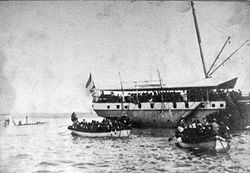Dutch intervention in Bali (1906)
| Dutch intervention in Bali (1906) | |||||||
|---|---|---|---|---|---|---|---|
 Dutch troops landing at Sanur, 1906.  Dutch cavalry at Sanur. |
|||||||
|
|||||||
| Belligerents | |||||||
|
|
Badung Tabanan Klungkung |
||||||
| Commanders and leaders | |||||||
|
|
|||||||
| Strength | |||||||
| 3 infantry battalions 1 cavalry detachment 2 artillery batteries Navy fleet |
|||||||
| Casualties and losses | |||||||
| Minimal | over 1,000 killed | ||||||
The Dutch intervention in Bali in 1906 was a Dutch military intervention in Bali, which destroyed the southern Bali kingdom of Badung and Tabanan, and weakened the kingdom of Klungkung. It was the sixth Dutch military intervention in Bali.
The Netherlands had already conquered northern Bali by the middle of the 19th century, integrating the kingdoms of Jembrana, Buleleng and Karangasem into the Dutch East Indies, but the southern kingdoms of Tabanan, Badung and Klungkung had managed to remain independent. Various disputes took place between the Dutch and the southern kingdoms, and it was expected that the Dutch would intervene militarily once a pretext presented itself.
There were recurrent disputes between the Dutch and Balinese kings regarding the right to plunder ships that foundered off the reefs surrounding Bali. According to Balinese tradition called tawan karang, the Balinese king traditionally considered such wrecks as their property, while the Dutch insisted they were not. On 27 May 1904, a Chinese schooner named Sri Kumala struck the reef near Sanur, and was plundered by the Balinese. Upon request for compensation by the Dutch, the kings of Badung refused to pay anything, supported by the king of Tabanan and the king of Klungkung. The ruler of Tabanan had also caused Dutch discontent by authorizing in 1904 the practice of suttee (ritual self-sacrifice of relatives upon the death of a ruler, also called wesatia) despite a Dutch formal request to abandon it.
In June 1906, the Dutch started a blockade of the southern coasts and sent various ultimata.
On September 14, 1906, a substantial force of the Royal Dutch East Indies Army, named the Sixth Military Expedition, landed at the northern part of Sanur beach. It was under the command of Major General M.B. Rost van Tonningen. Badung soldiers made some attacks on the bivouacs of the Dutch at Sanur on September 15, and there was some resistance again at Intaran village.
...
Wikipedia
